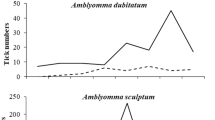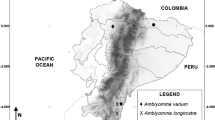Abstract
From 2005 to 2009, 147 ticks found on 32 wild animals from or referred to two zoobotanical parks (Parque Zoobotânico Arruda Câmara and Parque Estadual Dois Irmãos) located in northeastern Brazil were identified. Ticks found on two veterinarians working in one of the parks (i.e., Parque Estadual Dois Irmãos), after return from forested areas within the park’s territory, were also identified. The following tick-host associations were recorded: Amblyomma fuscum Neumann on Boa constrictor L.; Amblyomma longirostre Koch on Ramphastos vitellinus ariel Vigors and Coendou prehensilis (L.); Amblyomma varium Koch on Bradypus variegates Schinz; Amblyomma rotundatum Koch on Chelonoidis carbonaria (Spix), Chelonoidis denticulata (L.), Micrurus ibiboboca (Merrem), Python molurus bivittatus Kuhl, Iguana iguana (L.) and B. variegatus; Amblyomma nodosum Neumann on Myrmecophaga tridactyla L. and Tamandua tetradactyla (L.); and Rhipicephalus sanguineus (Latreille) on Nasua nasua (L.). The ticks found on the veterinarians were identified as nine Amblyomma larvae. The presence of Am. nodosum in Pernambuco and Am. rotundatum and Am. varium in Paraíba is recorded for the first time and the occurrence of Am. longirostre in Pernambuco is confirmed. Ramphastos vitellinus ariel is a new host record for Am. longirostre whereas M. ibiboboca and B. variegatus are new host records for Am. rotundatum. Finally, the human parasitism by Amblyomma ticks is reported for the first time in Pernambuco, highlighting the potential of tick-borne pathogen transmission in this state.
Similar content being viewed by others
References
Aragão HB (1911) Notas sobre ixódidas brazileiros. Mem Inst Oswaldo Cruz 3:145–195
Aragão HB (1936) Ixodidas brasileiros e de alguns paizes limitrophes. Mem Inst Oswaldo Cruz 31:759–843
Aragão HB, Fonseca F (1961) Notas de Ixodologia. VIII. Lista e chave para representantes da fauna Ixodológica Brasileira. Mem Inst Oswaldo Cruz 59:115–129
Barros-Battesti DM, Knysak I (1999) Catalogue of the Brazilian Ixodes (Acari: Ixodidae) material in the mite collection of the Instituto Butantan, São Paulo, Brazil. Pap Avulsos Zool 41:49–57
Barros-Battesti DM, Onofrio VC, Labruna MB, Martins JR, Guglielmone AA (2005) Redescription of Amblyomma fuscum Neumann, 1907 (Acari: Ixodidae), a rare South America tick confirmed in Brazil. Syst Parasitol 61:85–92
Bechara GH, Szabó MPJ, Almeida Filho WV, Bechara JN, Pereira RJ, Garcia JE, Pereira MC (2002) Ticks associated with armadillo Euphractus sexcinctus and anteater Myrmecophaga tridactyla of Emas national park, state of Goias, Brazil. Ann N Y Acad Sci 969:290–293
Bérnils RS (2009) Brazilian reptiles: list of species. Sociedade Brasileira de Herpetologia. Available via http://www.sbherpetologia.org.br/. Accessed 11 Jan 2009
Campos Pereira M, Szabó MPJ, Bechara GH et al (2000) Ticks (Acari: Ixodidae) associated with wild animals in the Pantanal region of Brazil. J Med Entomol 37:979–983
Cunha MCAL, Farias AMI, Brito FLC, Serra-Freire NM (1999) Ocorrência de Amblyomma fuscum Neumann, 1907 (Acari: Ixodidae) em Boa constrictor Linnaeus, 1758 (Reptilia: Boidae) no estado de Pernambuco, Brasil. Entomol Vect 6:577–579
Dantas-Torres F (2008a) Canine vector-borne diseases in Brazil. Parasit Vect 1:25
Dantas-Torres F (2008b) The brown dog tick, Rhipicephalus sanguineus (Latreille, 1806) (Acari: Ixodidae): from taxonomy to control. Vet Parasitol 152:173–185
Dantas-Torres F, Oliveira-Filho EF, Souza BOF, Sá FB (2005) First record of Amblyomma rotundatum Koch, 1844 (Acari: Ixodidae) parasitizing Crotalus durissus cascavella (Wagler, 1824) (Squamata: Viperidae) in the state of Pernambuco, Brazil. Arq Inst Biol 72:389–390
Dantas-Torres F, Figueredo LA, Brandão-Filho SP (2006) Rhipicephalus sanguineus (Acari: Ixodidae), the brown dog tick, parasitizing humans in Brazil. Rev Soc Bras Med Trop 39:64–67
Dantas-Torres F, Oliveira-Filho EF, Soares FA, Souza BO, Valença RB, Sá FB (2008) Ticks infesting amphibians and reptiles in Pernambuco, Northeastern Brazil. Rev Bras Parasitol Vet 17:218–221
Evans DE, Martins JR, Guglielmone AA (2000) A review of the ticks (Acari, ixodida) of Brazil, their hosts and geographic distribution-1. The state of Rio Grande do Sul, southern Brazil. Mem Inst Oswaldo Cruz 95:453–470
Guglielmone AA, Estrada-Peña A, Keirans JE, Robbins RG (2003) Ticks (Acari: Ixodida) of the Neotropical Zoogeographic Region. International Consortium on Ticks and Tick-borne Diseases (ICTTD-2), Atalanta
Guglielmone AA, Robbins RG, Apaneskevich DA, Petney TN, Estrada-Peña A, Horak IG (2009) Comments on controversial tick (Acari: Ixodida) species names and species described or resurrected from 2003 to 2008. Exp Appl Acarol 48:311–327
Guimarães JH, Tucci EC, Barros-Battesti DM (2001) Ectoparasitos de importância veterinária. Plêiade/FAPESP, São Paulo
Horak IG, Camicas JL, Keirans JE (2002) The Argasidae, Ixodidae and Nuttalliellidae (Acari: Ixodida): a world list of valid tick names. Exp Appl Acarol 28:27–54
Keirans JE, Durden LA (1998) Illustrated key to nymphs of the tick genus Amblyomma (Acari: Ixodidae) found in the United States. J Med Entomol 35:489–495
Labruna MB, Paula CD, Lima TF, Sana DA (2002) Ticks (Acari: Ixodidae) on wild animals from the Porto-Primavera hydroelectric power station area, Brazil. Mem Inst Oswaldo Cruz 97:1133–1136
Marques S, Barros-Battesti DM, Faccini JL, Onofrio VC (2002) Brazilian distribution of Amblyomma varium Koch, 1844 (Acari: Ixodidae), a common parasite of sloths (Mammalia: Xenarthra). Mem Inst Oswaldo Cruz 97:1141–1146
Martins JR, Medri IM, Oliveira CM, Guglielmone A (2004) Ocorrência de carrapatos em tamanduá-bandeira (Myrmecophaga tridactyla) e tamanduá-mirim (Tamandua tetradactyla) na região do Pantanal Sul Mato-Grossense, Brasil. Cienc Rural 34:293–295
Martins TF, Dantas-Torres F, Nieri-Bastos FA et al (in press) Host records for the immature stages of Amblyomma fuscum (Acari: Ixodidae), a South American tick species. Entomol News
Onofrio VC, Labruna MB, Pinter A, Giacomin FG, Barros-Battesti D (2006) Comentários e chaves para as espécies do gênero Amblyomma. In Barros-Battesti DM, Arzua M, Bechara GH (eds) Carrapatos de importância médico-veterinária da Região Neotropical: um guia ilustrado para identificação de espécies. Vox/ICTTD-3/Butantan, São Paulo, pp 53–113
Reis NR, Peracchi AL, Pedro WA, Lima IP (2006) Mamíferos do Brasil. Universidade Estadual de Londrina, Londrina
Robinson LE (1926) Ticks: a monograph of the Ixodoidea. Part IV. The genus Amblyomma. Cambridge University Press, London
Rohr CJ (1909) Estudos sobre Ixodidas do Brasil. Instituto Oswaldo Cruz, Rio de Janeiro
Sick H (1997) Ornitologia brasileira, 2nd edn. Nova Fronteira, Rio de Janeiro
Soares JF, Soares CDM, Gallio M et al (2009) Occurrence of Amblyomma longirostre in Ramphastos dicolorus in Southern Brazil. Cienc Rural 39:930–932
Szabó MPJ, Labruna MB, Vogliotti A, Duarte JMB (2006) Ticks (Acari: Ixodidae) on small red brocket deer (Mazama bororo Duarte) along deer trails in the Atlantic rain forest of Southeastern Brazil. Syst Appl Acarol 11:41–45
Szabó MP, Olegário MM, Santos AL (2007) Tick fauna from two locations in the Brazilian savannah. Exp Appl Acarol 43:73–84
Szabó MPJ, Pascoli GVT, Marçal Júnior O, Franchin AG, Torga K (2008) Carrapato vermelho do cão Rhipicephalus sanguineus parasitando Coereba flaveola no cerrado brasileiro. Cienc Rural 38:543–545
Acknowledgments
We thank the Parque Zoobotânico Arruda Câmara and the Parque Estadual Dois Irmãos for allowing us to develop this study.
Author information
Authors and Affiliations
Corresponding author
Rights and permissions
About this article
Cite this article
Dantas-Torres, F., Ferreira, D.R.A., de Melo, L.M. et al. Ticks on captive and free-living wild animals in northeastern Brazil. Exp Appl Acarol 50, 181–189 (2010). https://doi.org/10.1007/s10493-009-9296-5
Received:
Accepted:
Published:
Issue Date:
DOI: https://doi.org/10.1007/s10493-009-9296-5




